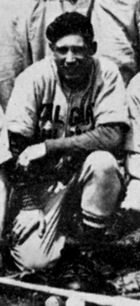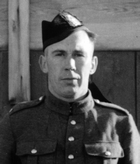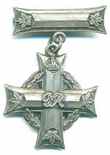Bill Hosie
| Date and Place of Birth: | March 3, 1912 Govanhill, Glasgow, Scotland |
| Date and Place of Death: | August 1, 1944 Caen, France |
| Baseball Experience: | Semi-Pro |
| Position: | Shortstop/Third Base |
| Rank: | Corporal |
| Military Unit: | Calgary Highlanders, Canadian Army |
| Area Served: | European Theater of Operations |
William Hosie was born in Govanhill, Glasgow in Scotland in 1912. His
father, Alex Hosie, was a tramcar conductor in the city and a champion
piper. The year William was born his father was invited to Medicine Hat
in Alberta, Canada, to join the Medicine Hat Kiltie Band – a bagpipe and
drum ensemble.
Medicine Hat, known as the Gas City because of its large natural gas
fields, is in south-eastern Alberta and about 175 miles south-east of
Calgary. The Medicine Hat Kiltie Band became well-known throughout
Canada and the United States until many of the band members signed up
with the Canadian Army at the start of the First World War. Seeing
service in Europe with the 17th Canadian Seaforth Highlanders, Alex
Hosie finished the war with the rank of Pipe Major. None of the other
members of the Kiltie Band survived the war.
While his father worked as a janitor at Elm Street School and performed
as pipe major in Medicine Hat’s Canadian Legion band, Bill Hosie was
earning a reputation as a fine baseball player. Professional baseball
had been played in Medicine Hat during the early part of the 20th
Century until the outbreak of World War I, with the Medicine Hat Hatters
being a mainstay of the Class D Western Canada League. When William
Hosie was playing baseball during the 1930s, the professional game was a
distant memory but southern Alberta still operated a top-class semi-pro
circuit with games often played before crowds of up to 4,000.
By 1934, Bill Hosie was the shortstop with the Medicine Hat Royals, who
played at Athletic Park on Riverside, helping them clinch the Senior
Alberta baseball championship that season. “Bill Hosie, Medicine Hat’s
slugging home run leader,” noted the Calgary Daily Herald after one of
his regular offensive outbursts in May 1934, “added further laurels to
his credit here Sunday afternoon and evening by slamming three home
runs, one three-base hit, two doubles and several singles in a
doubleheader exhibition tilt [against] the Lethbridge Cubs.”
Also that month the Daily Herald reported that Hosie “was the big hitter
of the afternoon” in a game against the Lethbridge Galt Miners sending
“sizzling drives in every direction, and in the fourth inning turned in
a beautiful homer.”
Hosie joined the Three Hills team later that season but returned to
Medicine Hat in 1935 and helped the Royals clinch the Southern Alberta
Semi-Pro League championship in 1936. The Royals became the Monarchs in
1937 and underwent a further name change in 1939 when they became the
Tigers. But 1939 was to be Hosie’s last summer of baseball in Medicine
Hat. On September 1, 1939, Germany invaded Poland, launching Hitler’s
tyrannical reign of terror and thrusting Europe into war. Days later,
Canada – a British Commonwealth country - declared war on Germany and
that same month 27-year-old Bill Hosie travelled to Calgary where he
enlisted in the Canadian Army with the Calgary Highlanders rather than
wait to be inducted.
Throughout the summer of 1940, the Highlanders trained in Shilo - a
remote training base in Manitoba – where inter-unit ballgames dominated
off-duty life. In late August, Corporal Hosie and the Calgary
Highlanders set sail for Britain aboard the SS Pasteur and arrived at
Gourock in Scotland on September 4, 1940. It was probably the first time
he had been in Scotland since shortly after his birth and the train that
took them to their new home at Guillemont Barracks, near Farnborough,
England, would have passed through his birth city of Glasgow.
The Highlanders assisted with the coastal defense of southern England
and trained in preparation for combat in Europe. During this time, Hosie
- who also boxed at both welterweight and middleweight -
captained the Highlanders baseball team which competed in the 2nd
Canadian Division league. On July 13, 1941, the Highlanders played the
South Saskatchewan Regiment baseball team at Bexhill-on-Sea; reportedly
the first time a baseball game had been played in the seaside town. In a
close fought contest on the town's cricket field which enjoyed a big
turn out from the local population, it was Bill Hosie who got things off
to a flying start with a deep drive to left field for a home run. "Both
teams were playing a swell brand of baseball, "reported The Glen - the
Highlanders' regimental magazine, "and double plays were a dime a dozen
with hot shoe-string catches thrown in for good measure." The game was
won in the last inning by the South Saskatchewan team with a final score
of 5-4.
On August 19, 1942, Hosie took part in the ill-fated Dieppe Raid. As
part of a 22-man mortar platoon – the only members of the Calgary
Highlanders assigned to the raid – Corporal Hosie was aboard landing
craft tank (LCT) 6 as it approached the German-held beach. Pieces of
shrapnel began clanging against the craft and pretty soon the
engine-room burst into flames. Although the crew managed to put out the
fire, when they were 70 yards from the beach the wheelhouse took a
direct hit that killed the helmsman. LCT 6 limped to the beach and
finally touched down on the shale; the gates creaked open, the ramp fell
and before them was Red Beach with dozens of dead and wounded Canadian
soldiers strewn across the stones. Amid merciless gunfire and total
chaos the LCT unloaded a bulldozer and two tanks that were promptly
immobilized. With little hope of being able to set up their mortars on
the beach, Hosie and his fellow Calgary Highlanders did not disembark
and remained with the LCT as it returned to the sea. Several times the
LCT went back to the beach – the mortar team still aboard – as they
attempted to rescue troops.
The Dieppe Raid was an unmitigated disaster. A total of 3,623 of the
6,086 men who made it ashore were either killed, wounded, or captured
and no major objectives were achieved.
Hosie remained in England with the Calgary Highlanders as they continued
to train in preparation for the assault on mainland Europe that would
come almost two years after the Dieppe debacle.
On July 6, 1944, one month after the Normandy landings, the Calgary
Highlanders landed in France. In Operation Spring, they were part of the
Battle of Verrières Ridge, along with the Black Watch, in which the
regiment took heavy casualties.
Corporal Hosie, aged 32, was killed in action in France on August 1,
1944, during the Battle for Caen – one of 36 Highlanders who lost their
lives that day. He was originally reported as missing in action; his
family were notified of his tragic death at the end of the month. Hosie
was survived by his wife (Cleo) and two children, his parents (Alex and
Lizzie), three sisters (Bessie, Reta and Ella) and a brother (Alfred).
Bill Hosie, husband, father, ballplayer and battlefield veteran, is
buried at the Bretteville-sur-Laize Canadian War Cemetery in Calvados,
France.
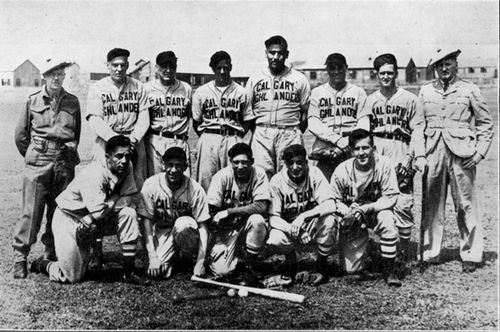
1941 Calgary Highlanders team in England.
Back row (left to right): Major G.E. Lockwood, Lt. W.H. Buchanan (C),
L/Cpl. R. Bray (CF), Fitzpatrick (P), Ferguson (P), Cpl. N. Wood (1B),
Cpl. H. Newman, and the Commanding Officer. Front row: H. Brabant, C.E.
Wheeler (LF), Bill Hosie (SS/3B), Sgt. W. Brotherton (RF), and T. Tardiff
(SS). Also on this team but not pictured were Armstrong (2B) and Logan.
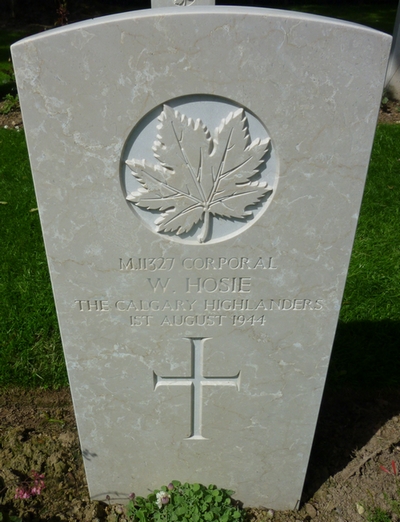
Bill Hosie's grave at the Bretteville-sur-Laize Canadian War Cemetery in Calvados, France.
Thanks to Sheila Drummond, Head of Reference Services at Medicine Hat Public Library and Tanya Field, Archives Clerk at Esplanade Arts and Heritage Center for help with this biography. Also many thanks to the Calgary Highlanders Regimental Museum and Archive for help with information and photos.
Date Added June 4, 2012. Updated May 12, 2017
Baseball's Greatest Sacrifice is associated with Baseball Almanac
Baseball's Greatest Sacrifice is proud to be sponsored by

